| Bees | Wasps | ||||
|---|---|---|---|---|---|
| Honeybee | Bumblebee | Yellow Jackets | Paper wasp (Polistes) | Bald-faced hornet | |
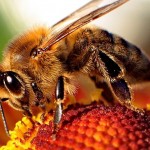 |
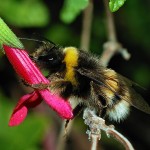 |
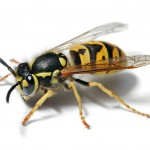 |
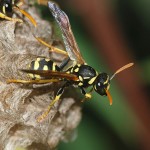 |
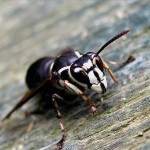 |
|
| Colors | varies but generally amber to brown translucent alternating with black stripes, some are mostly black | yellow with black stripes, sometimes with red tail, to dark | black and opaque bright yellow stripes | dusty yellow to dark brown or black | black and ivory white markings |
| Coat | furry (short hair) | furry (long hair) | smooth | ||
| Size | 1.3 cm (½ inch) | 2.5 cm (1 inch) or more | 1.3 cm (½ inch) | 1.9–2.5 cm (¾ to 1 inch) | up to 1.9 cm (¾ inch) |
| Legs | not generally visible while flying† | two long legs are visible hanging down during flight. no pollen baskets | long. no pollen baskets | ||
| Behavior to humans and animals | gentle, unless hive or queen is threatened ‡ Domesticated bees have been selected over time for gentleness. | gentle | aggressive | gentle | aggressive |
| Preferred food | nectar from flowers | other insects, overripe fruit, sugary drinks, human food and food waste, particularly meat* | other insects | ||
| Stinger character | barbed, is pulled out of the bee when it flies away, will lead to the death of the bee if used on a mammal | smooth, retracts, can be used indefinitely | |||
| Lives in | large colonies of flat wax-based honeycomb hanging vertically | small cavities in the soil | small umbrella-shaped papery combs hanging horizontally in protected spaces such as attics, eaves or soil cavities | large paper nest shaped like an upside-down pear usually hanging from branches or eaves | |
† When walking, you can often see light-colored pollen on the pollen baskets on a honeybee’s rear legs.
‡ There are several races of domesticated honeybees with varying characteristics of honey production, disease resistance and gentleness. Since the barbed stinger evolved for combat with other bees, the invariable outcome of stinging a mammal or bird is that the stinger becomes lodged in the victim’s skin and tears free from the honeybee’s body, leading to her death within minutes. As such, there is rarely any evolutionary advantage for a bee to sting a mammal to defend itself; honeybees will generally only sting when the hive is directly threatened, whereas honeybees found in the field or on a flower will rarely sting. Note: Africanized honeybees can be more aggressive than the more common European honeybees, but still only defend the hive.
* Yellow Jackets are carnivorous during the brood rearing part of the season. They feed insects to their brood, and obtain the sugar for their flight-muscle energy mostly from secretions of the brood. During this time they can be attracted to traps baited with meat or fish. Near the end of summer, when brood rearing ceases and this sugar source is no longer available, yellow jackets become frantic for sugar, and can be baited with sugar-based baits. They are also much more likely to visit fall flowers for nectar, than they are earlier in the season.